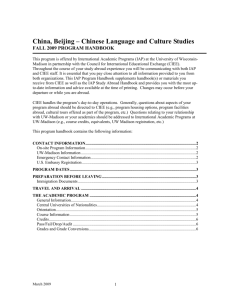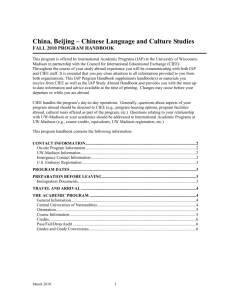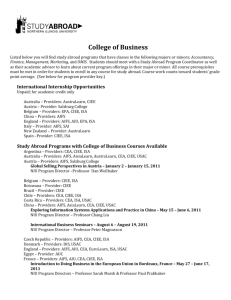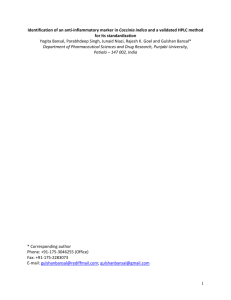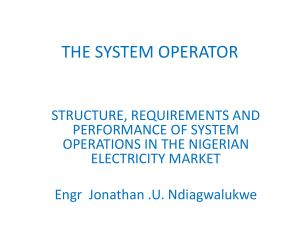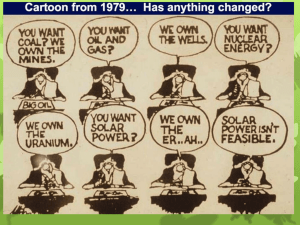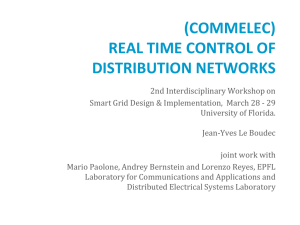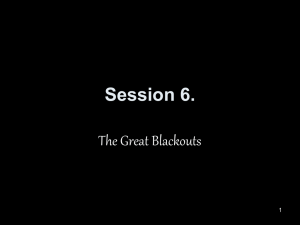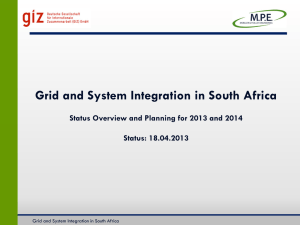- CIEE California Institute for Energy and Environment
advertisement
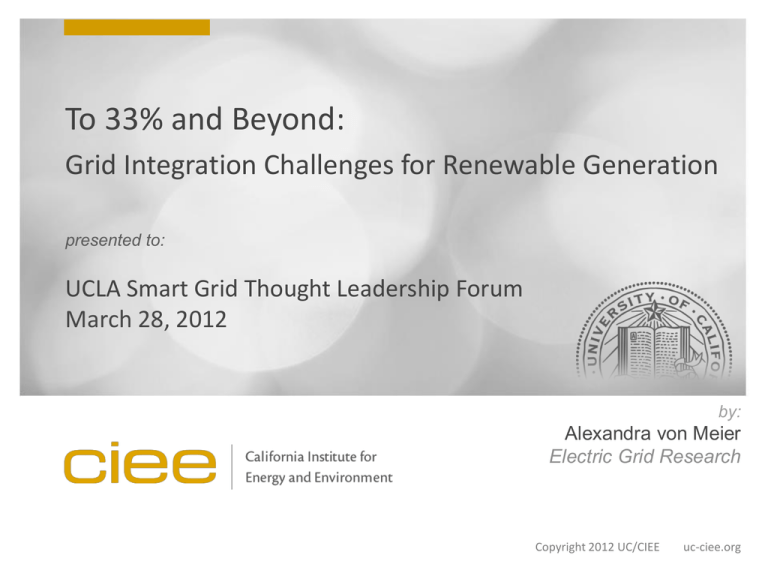
To 33% and Beyond: Grid Integration Challenges for Renewable Generation presented to: UCLA Smart Grid Thought Leadership Forum March 28, 2012 by: Alexandra von Meier Electric Grid Research Copyright 2012 UC/CIEE uc-ciee.org Disclaimer This presentation is based in part on work sponsored by the California Energy Commission, but does not necessarily represent the views of, nor has it been approved or disapproved by, the Energy Commission. The author gratefully acknowledges support from the Public Interest Energy Research program. March 28, 2012 Copyright 2012 UC/CIEE uc-ciee.org relative cost energy hardware information time March 28, 2012 Copyright 2012 UC/CIEE uc-ciee.org Historical drivers toward “smart grid” development • • • • • • • • • limited economies of scale oil prices high interest rates in 1970s and ’80s hampering large, inflexible units recognition of environmental costs PURPA: diversity of generators declining transmission investment increasing dependence on longdistance connectivity: vulnerability electronic loads: reliability needs, modeling challenge competitive market philosophy The grid is becoming harder to operate. Meanwhile, we want electricity that’s clean, green, good-looking, reliable… and cheaper, too! March 28, 2012 Copyright 2012 UC/CIEE uc-ciee.org Problems are difficult but solvable 33% by 2020 in CA 12,000 MW in distributed installations 100% ? March 28, 2012 Copyright 2012 UC/CIEE uc-ciee.org Time scales in electric grid operation March 28, 2012 Copyright 2012 UC/CIEE uc-ciee.org courtesy of Tom Bialek, SDG&E Addressing resource intermittence Firming resources: • load-following and reserve generation • storage • demand response …whose effective and economical coordination depends on: • good forecasts important areas for continuing • real-time data research – not just devices, but • fast response their coordination • good algorithms March 28, 2012 Copyright 2012 UC/CIEE uc-ciee.org Addressing resource intermittence Firming resources: • load-following and reserve generation • storage • demand response …on different time scales: seasonal day-ahead hour intra-hour minutes seconds cycles March 28, 2012 …suggesting new definitions of ancillary services? frequency regulation inertia Copyright 2012 UC/CIEE uc-ciee.org Low-frequency oscillations in the Western U.S. grid 34 1 119 2 2 4 80 117 106 81 79 7 6 10 18 3 230 7 12 4 5 13 85 9 20 10 24 6 15 31 28 82 13 84 8 0 50 0 23 111 33 14 103 500 230 11 86 83 32 77 87 102 88 15 500/345 35 89 110 37 105 500/345 16 90 230 345 75 101 31 104 38 33 100 39 230 17 40 108 42 5 34 0 50 18 29 94 72 24 114 345 500 25 99 46 115 98 116 20 19 28 91 230 113 67 97 92 52 230 22 345 5 34 49 96 66 93 21 30 69 57 44 North-South 0.25-0.3 Hz 23 54 26 61 27 63 March 28, 2012 Copyright 2012 UC/CIEE uc-ciee.org Example of North – South Oscillation… …which ended in the August 10th, 1996 power outage in the Western U.S. March 28, 2012 Copyright 2012 UC/CIEE uc-ciee.org Low-frequency oscillations in the Western U.S. grid 34 1 119 2 2 4 80 117 106 81 79 7 6 10 18 3 230 7 12 4 5 13 85 9 20 10 24 6 15 31 28 82 13 84 8 0 50 0 23 111 33 14 103 500 230 11 86 83 32 Note: these problems pre-date high penetrations of renewables! North-South 77 87 15 500/345 35 37 16 102 88 89 110 105 500/345 90 230 345 75 101 31 104 38 33 100 39 230 17 40 108 42 5 34 0 50 18 29 94 345 500 25 99 46 115 98 116 19 28 91 230 113 67 97 92 52 230 22 345 5 34 49 96 66 93 21 0.25-0.3 Hz 72 24 114 20 30 69 57 44 23 54 26 61 27 63 March 28, 2012 Copyright 2012 UC/CIEE uc-ciee.org Coordination challenges in time • • • • • Matching PIN = POUT on different scales Constrained by ramp rates (dP/dt) of resources Maintaining stability on the scale of seconds, cycles Long-distance a.c. transmission constrained by stability Impact of switch-controlled generators (inverters) on angle stability not yet well understood Requires management at the sub-cycle level: synchrophasors ac-dc-ac conversion chopping up waveform with solid-state technology power flow control devices March 28, 2012 Copyright 2012 UC/CIEE uc-ciee.org Distance scales in electric grid operation March 28, 2012 Copyright 2012 UC/CIEE uc-ciee.org www.trans-elect.com Distribution vs. transmission systems Important differences: March 28, 2012 • • • • • architecture diversity time variation vulnerability opacity Copyright 2012 UC/CIEE uc-ciee.org Illustration: Michael Sowa Distributed siting and local issues • Generation and load modeling • Voltage regulation • Protection • Islanding • Unexpected phenomena March 28, 2012 Copyright 2012 UC/CIEE uc-ciee.org Distributed siting and local issues • Generation and load modeling • Voltage regulation • Protection • Islanding • Unexpected phenomena March 28, 2012 Copyright 2012 UC/CIEE uc-ciee.org Distributed siting and local issues • Generation and load modeling • Voltage regulation • Protection • Islanding • Unexpected phenomena March 28, 2012 Copyright 2012 UC/CIEE uc-ciee.org Distributed siting and local issues • Generation and load modeling • Voltage regulation • Protection • Islanding • Unexpected phenomena power island March 28, 2012 Copyright 2012 UC/CIEE uc-ciee.org Distributed siting and local issues • Generation and load modeling • Voltage regulation ? • Protection • Islanding • Unexpected phenomena March 28, 2012 Copyright 2012 UC/CIEE uc-ciee.org Distribution Monitoring Initiative Distribution Monitoring for Renewables Integration to be funded by PIER/California Energy Commission collaborative effort with CA utilities plan to install 3 line sensors each on ca. 20 circuits for each utility sub-cycle sampling rates include circuits with different penetration levels of DG installed look for comparative impacts of DG obtain baseline feeder behavior data attempt typology of distribution feeders use data to validate existing distribution circuit models use data to develop and validate models of new components in distribution systems Technologies under development for refined observation and control • four-quadrant (P,Q) inverters volt-VAR control • advanced inverters harmonic cancellation transient mitigation • • • • • • distributed storage micro-synchrophasors power routers solid-state transformer responsive loads communication networks March 28, 2012 distributed resources & coordination tools increasingly provide the capability to balance power and manage power quality & reliability locally Copyright 2012 UC/CIEE uc-ciee.org Future directions Refined observation and control in time and space • driven by the need to mitigate pre-existing vulnerabilities of the legacy system, much amplified by intermittent renewable resources • providing the means to observe, communicate and control at higher resolution while maintaining large-scale awareness Trend toward adding new capabilities on the grid’s periphery • resonant with philosophical and aesthetic preferences of many ratepayers who embrace “going local, going green” • may enable more local diversity, flexible management options and more systemic value derived from renewable and distributed resources March 28, 2012 Copyright 2012 UC/CIEE uc-ciee.org Alexandra “Sascha” von Meier California Institute for Energy and Environment (CIEE) http://uc-ciee.org vonmeier@uc-ciee.org
